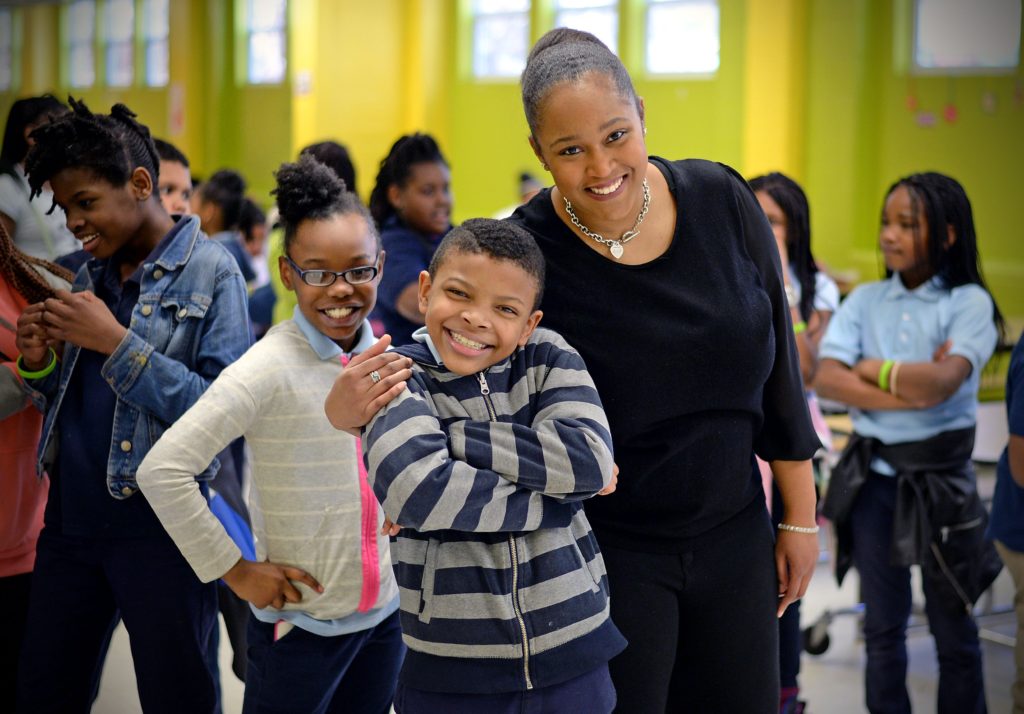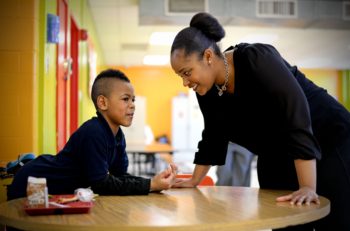In a struggling school district, Keyria Jeffries advocates for students most in need

Brown School of Social Work student Keyria Jeffries works with 4th grade students at Fairview Elementary School in Jennings, MO.
James Byard/WUSTL Photos
As a social work practicum student, Keyria Jeffries will do anything to help the children of Fairview Primary in the Jennings School District. Some days, that means giving a hungry child a granola bar. Other days, it means finding a child a place to live.
“It’s about serving the whole child,” says Jeffries, a student at the Brown School at Washington University in St Louis.
Jeffries’ students face many obstacles. Almost all of Fairview’s 276 students are poor. Some are homeless; others are survivors of violence. Indeed, the school is not far from where Michael Brown was shot and the ensuing unrest that destroyed many businesses. And last spring, students mourned together after a 6-year-old classmate died in a house fire with her baby brother and grandmother.
But those are just challenges, says Jeffries, not excuses.
“Some people shrug and say, ‘Well, what can you do,’ Jeffries says. “The problems here are big, but they are not insurmountable. Just look at everything Jennings has accomplished by addressing the greater needs of students and the community.”

Brown School of Social Work student Keyria Jeffries works with 4th grade students at Fairview Elementary School in Jennings, MO. James Byard/WUSTL Photos
Under the visionary leadership of Superintendent Tiffany Anderson, the Jennings School District recently regained state accreditation because of strides made both inside and outside the classroom. For instance: attendance. Fairview’s rate now matches the state average, an enormous accomplishment that boosts both student performance and state funding. Jeffries spends a big part of her day tracking down missing students.
“We are required to contact the state after 10 absences, but we don’t wait for that,” Jeffries says. “We reach parents and say, ‘What can we do to help?’ Maybe they are dealing with circumstances — trouble with transportation or housing. We’ve seen it all, heard it all, and we’re ready to help.”
For instance, a teacher recently alerted Jeffries that a student’s clothes were soiled. Jeffries talked to the child and learned his family was living in a homeless shelter. First things first, Jeffries washed the student’s clothes; every Jennings school has a washer and dryer, and Jeffries uses them frequently. Then, she reached out to the student’s mom.
“Parents aren’t always happy to hear from us,” she says. “There is a stigma, ‘Oh, you want to take my kids away.’ That’s not what we are here for. When they see that I am genuinely there for them, they become more relaxed and more open to help.”
Jeffries told the mom about various programs and connected her with community resources.
“It’s about using the tools in your tool box,” Jeffries says.
And, sometimes, making your own tools.
Jennings recently opened its own foster home called Hope House and the SPOT Clinic, which offers free confidential medical and mental health care. Washington University School of Medicine staff operate the clinic.
“What is great about this experience is the all-hands-on-deck atmosphere,” Jeffries says. “You never hear, ‘Well that’s not my job.’ Somebody has to do it; it doesn’t matter who.”
Jeffries’ practicum work supports her education as a Brown student. The school’s Urban Education Initiative, managed by Aaron Jennings, MSW ’09, prepares students to take leadership roles in city schools, creates partnerships with public and charter schools across the region, and helps schools implement and measure programs to improve the social, emotional and community health of their students.
“The combination of theory and practice has really prepared me for this work,” says Jeffries, who also served as a practicum student at Roosevelt High School in St. Louis Public Schools. “In class, I get to hear what things are like in Cahokia (Illinois), in East St. Louis (Illinois), in Pattonville (Missouri). I can’t be in more than one place, but hearing about those experiences from other students has broadened my knowledge.”
Jeffries is not sure what’s next after graduation this spring. She is from Chicago and would like to return home. But she wouldn’t say no to a job in St. Louis. This much is certain — she wants to work in an urban school.
“The kiddos may not know what our job title is, but they know this person can help you,” Jeffries says. “We are always getting smiles and hugs and hellos. Once kids know that you care about them — she washed my clothes, she gave me a granola bar — they remember that. They know this is a person who cares.”
by Diane Toroian Keaggy